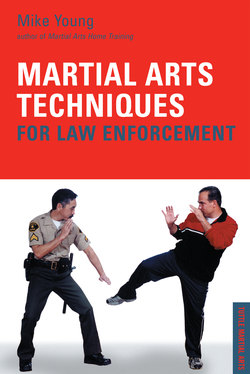Читать книгу Martial Arts Techniques for Law Enforcement - Mike Young - Страница 12
На сайте Литреса книга снята с продажи.
Оглавление3
A Basic Stance for Self-Defense
Each of the martial arts practiced throughout the world has developed a “signature” basic stance—the starting point for its techniques or movements. These stances are based on the needs of the fighters who use the style. For example, southern Chinese martial arts developed a wide “horse” stance to give their practitioners’ stability in their wet environment (see Fig. 4).
The stance used by Indonesian ground tiger (harimau) fighters is low and close to the ground because of the unpredictability of the terrain in that region (see Fig. 5).
Police work has its own special demands—and requires its own unique approach. Officers who stand in the basic FI (field interrogation) stance, for example, leave themselves vulnerable to a street fighter’s kick to the leg. The standard low “horse” or traditional forward stance used in the martial arts is also not very functional in the demanding and dangerous situations faced in law enforcement. In police work, mobility is critical—especially when facing a larger assailant.
The best stance for law enforcement work is a modified version of the standard, modern kickboxing stance. In this stance the feet are set slightly wider than shoulder width, the knees are bent slightly, and the feet are slightly offset, with weight distributed evenly between them. The hands are held up around eye level, the elbows are tucked in, as is the head, the shoulders are raised slightly, the rear foot heel is raised slightly, and the lead foot is turned in slightly (see Fig. 6).
Every facet of this stance has a functional purpose:
Foot position: Setting the feet at shoulder width offers quick mobility in any direction when compared to the broader, lower “horse” stance. Placing one foot slightly offset from the other gives you a little more stability in your stance, as opposed to placing one foot behind the other. Placing one foot directly behind the other foot—known as tightrope walking in kickboxing—would give you good forward stability but would limit your lateral stability (see Fig. 7).
Your weight is distributed equally between your feet, again so that you can move quickly in either direction. The front foot is kept slightly turned in to protect you from getting kicked in the groin. This turns your knee in as well, so that it can protect your groin.
The heel of your rear foot is raised slightly to give you a little more spring if you need to lunge forward. Raising your rear foot heel also provides a “shock absorber” should you get hit. You can rock back on the heel of your rear foot, absorbing the power of the blow to your body (see Fig. 8).
Knees: The slightly bent knees also give you better mobility. Look at how tennis players stand when they are receiving a serve. Their knees are bent so that they can move in any direction as quickly as possible (see Fig. 9). The bent knee also gives you protection against a quick knee attack. Every martial artist knows that it is easier to break a straight leg than a bent one. Many street fighters say that they wait for their opponent’s leg to straighten out before they kick it—so that they can break it (see Figs. 10 and 11).
Hands: Your hands should be held up at eye level. With your hands in this position, it is easier to block an incoming blow to the face. I prove this theory with cadets by telling them that those who do not keep their hands up when they box with me will get hit in the head. Ninety-nine percent of them will get hit in the head—but only if they drop their hands below eye level. When the cadets and police officers that I have trained keep their hands at eye level, they can block 80 percent of all incoming punches to the head.
Elbows: Your elbows are tucked in to protect you from getting hit in the body. Your elbows act as a defensive shield to block any incoming blows to the body.
To show how important it is to block a body blow with your elbows, I always tell my students that if they don’t do this, I’ll knock the wind out of them. To date, I have knocked the wind out of well over 10,000 students—with either a punch or a kick—because they didn’t keep their elbows tucked in. More than half of these were police officers. Many police officers believe that if they wear a vest in the field a body blow cannot drop them. I prove them wrong when I spar with them—with them wearing a bulletproof vest. The results are the same—with the vest on, I just hit them a little harder.
Getting dropped by a body blow could be fatal to an officer involved in an altercation, which is why I am an avid believer in keeping the elbows tucked in. The real beauty of the elbow block, though, is that it does not compromise your defensive stance. I have personally broken many people’s hands with a simple elbow block.
Head and shoulders: Your head is also tucked in and your shoulder raised slightly to protect what I affectionately call the “knockout band”—the six-inch parallel line that runs around the front of the head from the nose to the chin (see Fig. 12). Boxing trainers direct their fighters to hit this area to knock their opponents out. Tucking your head and raising your shoulder hides and protects this imaginary line.
It takes only a few minutes of dedicated practice to become proficient in this basic stance. Next, you need to learn how to move using this stance to be effective.
